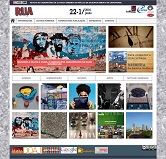Resumo
This paper intends to discuss the ways Street Art has been promoting new affective inscriptions in the urban landscape of São Paulo city. This practice is verified through works promoting “sensible shocks”, which occur using signs that sensibilize the passerby’s look. The discussion starts addressing local cultural art movements in order to show how Brazilian Street Art is linked to other forms of politicization in the cities. Then, it is shown how the articulation of structures of feeling can be observed in the city in events involving disagreements between graffiti artistis and the municipal government. Finally, it is argued that the affective inscriptions reveal the social structures of the city and contribute to highlight imbalances between expectation and reality.
Referências
BANKSY. Wall and Piece. Randon House UK, 2007.
BEST, Beverly. “Raymond Williams and the Structure of Feeling of Reality TV”. In: International Journal of Humanities and Social Science, vol. 2, no. 7; April 2012.
BRIGHENTI, Andrea. At the Wall: Graffiti Writers, Urban Territoriality and the Public Domain. In: Space and Culture, vol. 13, no. 3, 2010, p. 315-322.
FILMER, Paul. “A estrutura do sentimento e das formações socioculturais: o sentido de literatura e de experiência para a sociologia da cultura de Raymond Williams”. In: Estudos de Sociologia, Araraquara, v.14, no.27, 2009, p.371-396.
FUREDY, F. Therapy culture: cultivating vulnerability in an uncertain age. London: Routledge, 2003.
ILLOUZ, E. Saving the modern soul: therapies, emotions, and the culture of self-help. University of California Press, 2011a.
ILLOUZ, E. O amor nos tempos do capitalismo. Rio de Janeiro: Zahar. 2011b.
MATTELARD, A & NEVEU, E. Introdução aos Estudos Culturais. São Paulo: Parábola Editorial, 2004.
RANCIÈRE, Jacques. O destino das imagens. Rio de Janeiro: Contraponto, 2012.
RANCIÈRE, Jacques. A partilha do sensível: estética e política. São Paulo: Ed. 34, 2009.
RANCIÈRE, Jacques. “Política da arte”. In: Urdimento – Revista de Estudos em Artes Cênicas. Universidade do Estado de Santa Catarina, vol 1, n. 15. Florianópolis: UDESC / CEART, 2010.
SIMMEL, Georg. On Individuality and Social Forms. Chicago and London: The university of Chicago Press, 1972.
VIANA, Silvia. “Será que formulamos mal a pergunta?” In: Cidades Rebeldes. São Paulo: Boitempo, 2013.
WILLIAMS, Raymond. “Culture is Ordinary”. In: Resources of hope: culture, democracy, socialism. London: Verso, 1989, p. 3-14.
O periódico RUA utiliza a licença do Creative Commons (CC), preservando assim, a integridade dos artigos em ambiente de acesso aberto.

